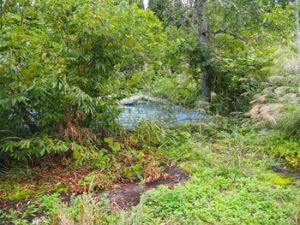Series “Visiting Villages” 41 What does it mean to close a community? Walking through the farm hut settlements of Showa Village, Fukushima Prefecture②

A highway from the Edo period ran through the farmhouse settlement, and many people reportedly traveled there at the time. Over the long course of human history, human populations have fluctuated. Accordingly, the land used by humans has also grown and shrunk. (Kei Kitajima)
A long gravel road runs through the farmhouse settlement. This road was a highway during the Edo period, leading to Aizu-Tajima, a territory directly controlled by the shogunate. It includes the Rolling Stone Pass, where woodworkers crossed the pass and passed through Aizu-Tajima to Aizu-Wakamatsu to sell wood for Aizu lacquerware. It is said that many people traveled there at the time. Records of a conflict between the government army and the Aizu clan during the Meiji Restoration, when the government army burned down the settlement, led the villagers to hide in the mountains to escape. Once the fighting ended, the residents rebuilt the burnt-down village.
While Hatagoya Village has a rich history, it is now deserted and closed as a settlement.
Hiroaki says, “Over the long course of human history, the population has risen and fallen. Along with that, the land used by humans has also grown and shrunk. Japan’s current population is around 120 million, but during the Meiji period it was around 40 million. And from now on, Japan’s population will approach that of the Meiji period. How do we close off the land that has expanded over time and return it to nature? The idea of returning the land that humans borrowed from the gods in order to survive to the gods when they no longer use it is probably one that is comforting to the Japanese psyche.”

豪雪で倒壊した無人の住宅。草木に覆われ屋根だけ目視できる(An uninhabited house collapsed due to heavy snowfall. Only the roof is visible, covered by vegetation.)
Wandering aimlessly through Hatagoya Village, I came across a completely collapsed building. Covered in vegetation, only the blue roof remained. It was the home of Ogura Mataichi.
The deceased passed away shortly after the shrine was demolished, and the abandoned house was crushed by heavy snow and left to decay.
The scene I was witnessing may have been a representation of the house being returned to nature. This must be what it means to return something to the gods and return it to nature.
“When Mataichi lived here, there was a water source at the back of the house, and various fruit trees were planted. Mataichi had everything necessary for daily life prepared around the house. I really want to find out what humans actually need to live,” says Hiroaki.
After leaving the Hatagoya settlement, we headed for Onogawa Ogi.
There you will find Oedazawa Tengu Shrine (commonly known as “Tengu-sama”).
In the car, we talked about the Great East Japan Earthquake that occurred on March 11, 2011.
Apparently, a particular problem at the time was the shortage of gasoline. Showa Village is often hit by heavy snowfall and bitter cold in March. Villagers kept warm with kerosene heaters, but were careful not to run out of oil.
Hiroaki recalls, “We get into town by car, so it was very difficult when gasoline restrictions were put in place. At the time, the power outage lasted for about three days, but we were able to quickly deal with the outage. However, we struggled with the gasoline shortage.”
Over a decade has passed since then, and agriculture, tourism, and other forms of human interaction have returned to pre-disaster levels, but the effects of radioactive materials continue to this day.
Because radioactive materials remain in the soil of the mountain forests in particular, for example, local trees cannot be used as logs for shiitake mushroom cultivation, and logs must be purchased from Kyushu. The same is true for mushrooms; mushrooms picked in the mountains cannot be sold. Wild animals such as deer, wild boar, and bear live in the mountain forests, and it would be possible to develop game meat as a local resource, but currently this is not permitted.
His wife Yoko says, “Some locals eat mushrooms and game, but they can’t sell it. Even among the locals, young people who may have children in the future avoid it. Most of the people who eat it are elderly people.”
On the other hand, farm products such as rice and baby’s breath are completely fine.
Hiroaki adds, “After the earthquake, we sprayed a lot of potassium on the farmland. Potassium adsorbs radioactive materials, so plants no longer absorb them. But it’s difficult to spread potassium deep into the mountains, so mountain produce such as shiitake mushrooms and other mushrooms are still being affected”.
※Translating Japanese articles into English with AI
